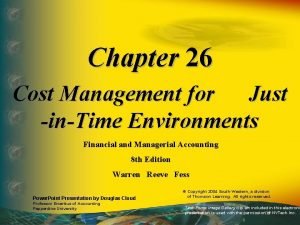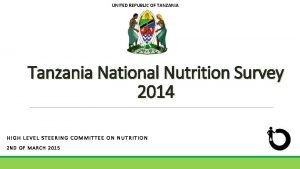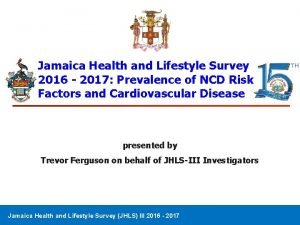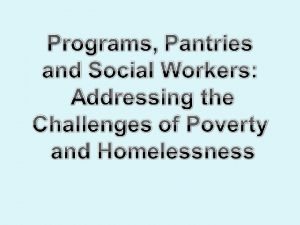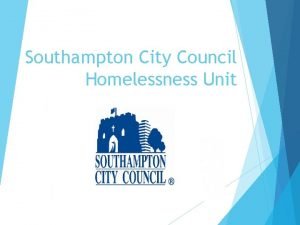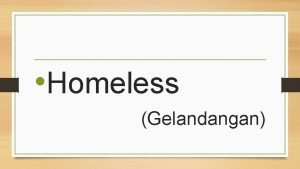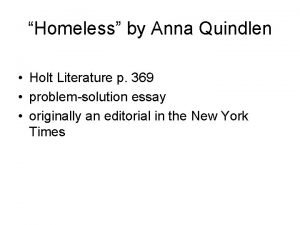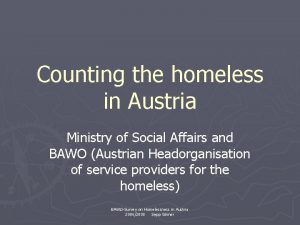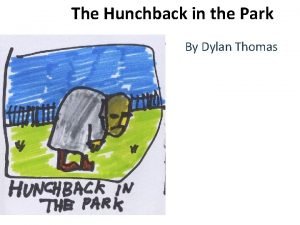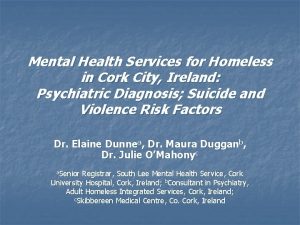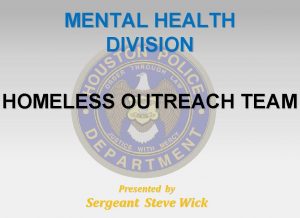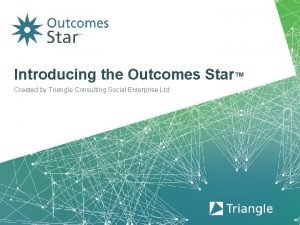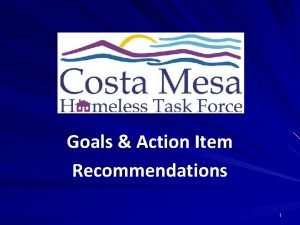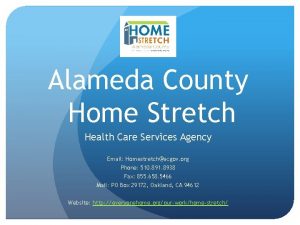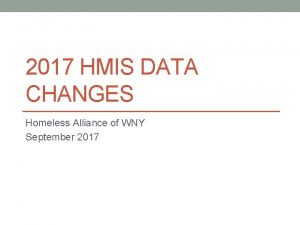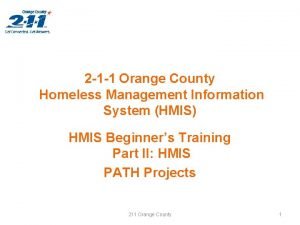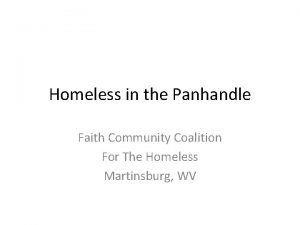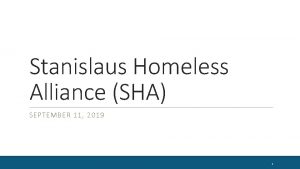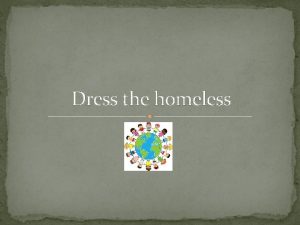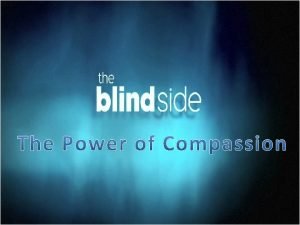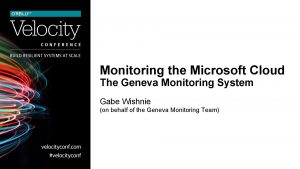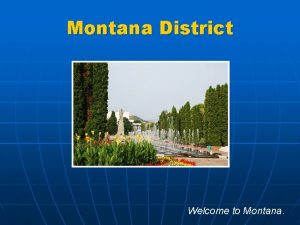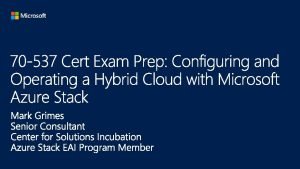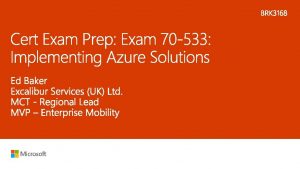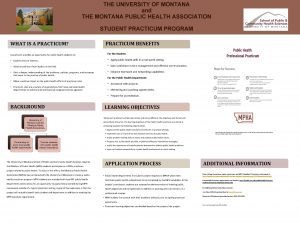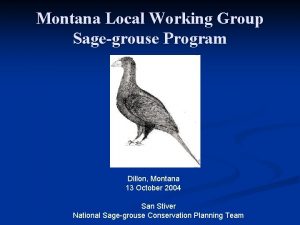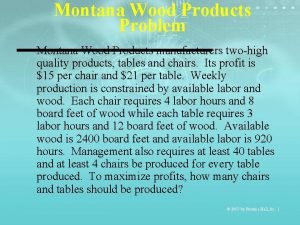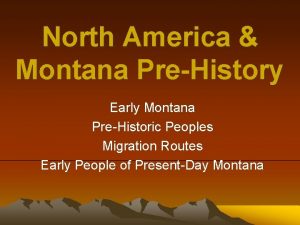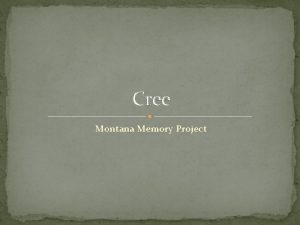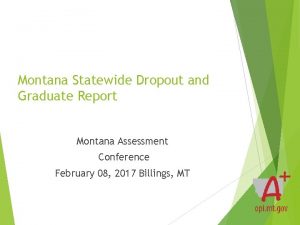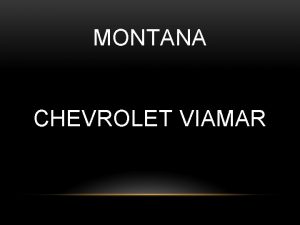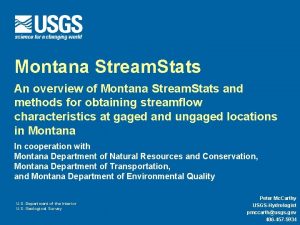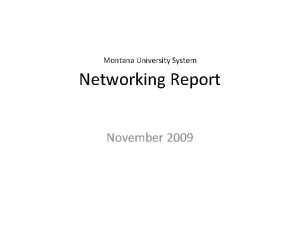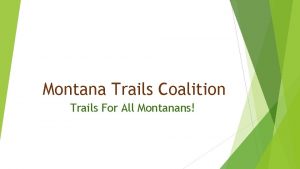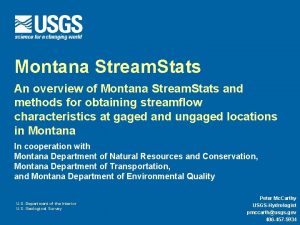2019 Montana Homeless Survey aka Point inTime or




































- Slides: 36

2019 Montana Homeless Survey (aka Point -in-Time, or PIT) TRAINING – Volunteers & Interviewers Sponsored by MT Continuum of Care Coalition, MT Dept of Health & Human Services & MT HRDC Association 1

§ Nationwide, Simultaneous. Backgroun d § Basis for Congressional Funding. § Public Awareness. § Local/State Planning, Grant-writing. §Scored Co. C Grant Item: $2. 5 m for 17 HUD grants to MT 2

§ Coverage: § Site ID (sheltered & outside). Goals § Consistency: § Nationwide, year-to-year. § Statewide coordination & protocol. § Accuracy: § Using best practices. § Volunteer recruitment & training. 3

Live trainings upon request. Addition al Training & Info Volunteer Interviewer Training Video Link to website: https: //montanacoc. org/ 4

All client information gathered is confidential. Signed Confidentialit y Agreements All client surveys will be protected and kept out of public view. Entering known, inaccurate information about any client is prohibited. 5

• Wrong time of year. • Same survey date across the nation. • Need to answer all the questions? Frequently Asked Questions & Issues • Ask all but answers are voluntary. • Gender & Ages needed (observation allowed). • Some questions too personal • Pass on any question respondent wishes. • Need to define homeless • No need. Survey accommodates all definitions in “where slept” options. 6

PIT Is 2 Surveys Unsheltered (outside, streets): Service-based sites. Survey Sites Sheltered sites: Emergency shelters. Domestic Violence shelters. Motel Vouchers. Transitional Housing programs. 7

§ “Night of” Thursday, January 31 st. § Sunset on 31 st to Sunrise on Feb 1 st. When to Survey § DO NOT survey before Jan 31 st. § 90% of effort on 31 st – Feb 1 st. § Service-site surveys through Feb 7 th. § Captures “unsheltered” missed on night of PIT. § Using service sites. § 10% effort Feb 1 st to Feb 7 th. 8

Unsheltere d WHERE - UNSHELTERED §Primary nighttime residence is place not meant for habitation on night of count, e. g. on the street, under bridge, in a camp, park, vehicle, bus station or abandoned structure. §Known streets, blocks. §Empty buildings. §Camps, campgrounds. §Overpasses, bridges. §Libraries. 9

Where: Service Based Sites § Project Homeless Connect events § Food banks § Thrift stores § HRDCs § Salvation Army § Churches § Healthcare for Homeless Clinics § Community Mental Health Centers § Community Health Clinics 10

Sites in the Housing Inventory Where: Sheltered §Emergency Shelters § Domestic Violence shelters. § Programs providing motel vouchers. §Transitional Housing § w/year round beds dedicated to homeless. 11

# 1: Interviewer is best. Who Fills Out the Survey? Highest response & accuracy. Need training & practice. # 2: Homeless person him/herself with assistance. # 3: Case Manager, when necessary. 12

• Interviewer Training Video Interviewer Training • Practice w/ a dry run: the more you know the questions, the greater your comfort level in asking, the more likely you will gain the trust of the respondent. Patience – 10 minute interview. 13

§ Hello, my name is ____ and I’m a volunteer with ____. The “Ask” § We’re conducting a survey to count homeless people to provide better programs and services. § All answers are confidential, anonymous, voluntary and passing on any question will in no way result in refusal of services. § Can I have about 10 minutes of your time? § Answer only questions you want, just say “Pass” to skip a question. 14

§ Use only pen or #2 pencil. § Read by a scanner. § Don’t use felt tip markers. Important Details § Bleeds through paper and not read by scanner. § Only 1 per household (or family). § Do not survey every member in a family. § Try to survey head of household. § Fill in oval; don’t use X’s or checks. § Write only where indicated. 15

Walkthrough Highlights Front page-Facility Identification. Interviewer shortcuts. Ask & translate. Total number of days homeless? Respondent identifier box. Demographics table for accompanying members. 16

§ Box on front page: ID facility. § Must be filled in for surveys at a shelter or TH. Front Page – Facility ID § It is the responsibility of sheltered staff. § If you are a volunteer at a sheltered facility, please check w/ staff to be sure this is filled out. § Missing facilities counted as not participating. § If interviewing outside or on the streets, ignore the Facility ID box. 17

Facility Identification 18

Ask each question in order and as written. This is the default whenever there is doubt. Interviewer Shortcut 1 Some questions/answers are translatable. Reading all of the options not always necessary, BUT REQUIRES thorough understanding of the question and the options. 19

Question # 4: Where Slept? Interviewer Shortcut 2 Ask, translate, follow-up Requires understanding the options. First 5 Options are HUD Homeless—most important. Unsheltered: Outside Sheltered: ES, DVS, Voucher, TH Options: Motel: paid voucher or paid by self. Friends or Family: emergency/short duration or voluntary long duration. Apartment or house: subsidy or paid by self. 20

# 7. How long have you been (homeless)? This is the most recent, single occurrence. Interviewer Shortcut 3 # 8. How many times have you been homeless? #10. How long have you been in this community? Ask question and fit response to appropriate option if the answer is clear. Otherwise, read the options and let the respondent choose. 21

#14. Been to emergency room? #15. Been arrested or jailed? Interviewer Shortcut 4 Ask question, and if yes, followup with options. Once Twice 3 times or more 22

Best to read all of the options for the following: #5 and #6. Veteran status and active duty. No Short Cut for Some Question s #11. Do you have any income? #12 Are you receiving any cash benefits? #13. Did you leave last residence for any of these reasons? # 16. Including yourself, how many adults and children are in your household, that is, sleeping at the same location with you…. . Accompanying persons demographic items. 23

Question #9: Total days homeless “For all of the times you’ve been homeless in the last 3 years, what is your best estimate for the total number of days you were homeless: ” q Less than 12 months q 12 months or more Required to better identify Chronic Homelessness. Expect that this question might be difficult to answer. Just a “best guess, ” given only 2 options. 24

When collecting data on disability status for the PIT count, Co. Cs must ensure: Disability Question Volunteers administering the survey know that these questions must be asked of all persons being surveyed and it is completely voluntary whether persons respond to questions about disability status, and, persons being surveyed are informed prior to responding to any disability question that their response is voluntary and that their refusal to respond will not result in a denial of service. 25

What is a Disability? A physical, mental, or emotional impairment, including an impairment caused by alcohol or drug abuse, post -traumatic stress disorder, or brain injury that: is expected to be long-continuing or of indefinite duration; substantially impedes the individual's ability to live independently. 26

Identifier Information 27

HUD requires us to demonstrate a deduplication process. MT Co. C protects anonymity. Identifier Information (continued) Need the 3 pieces of information: First “Full” name (not nicknames). Initial of last name. “Day” of birth, e. g. “ 16” for October 16, 1980. Interview Head of Household, if possible. 28

1 box for self/respondent. Separate page for accompanying persons. Age: best guess only if person declines. Demographic s Table - Self Gender: by observation if person declines. Race Mark all that apply or add “other. ” By observation only if person declines. 29

Demographi cs Table Self 30

“Including yourself, how many adults and children are in your household (sleeping at the same location with you on the night of the survey)? If the total is more than one, please continue to back page. ” Question 16: # in Household Total # in Household= Self + all accompanying. Accompanying persons: Sleeping with respondent on night of survey! If only one, then only self column filled in. 31

Accompanyi ng Members Children: Must be “with” respondent. If you don’t see them, ask. Do not count children living somewhere else. 32

In 2017, “Transgender” ( Response #4) changed to: Gender Question “Gender non-conforming (i. e. not exclusively male or female). ” “Important for interviewers to be sensitive to gender identity. ” 33

Demographic Table Accompanying Only 5 columns/persons. Attach separate survey for additional members. Relation to respondent. Ages: Best guess by observation only if necessary. Gender and ethnicity: By observation, if necessary. Race: Mark all that apply or add “other. ” By observation, if necessary. Disability – Other household members: Applies to children. Requires respondent answer. Job and stable living may or may not apply. 34

Contact: Email: mtcoc. coalition@gmail. com Greg Owens: (406) 595 -3888 Hotline on 31 st - (406) 920 -0468 Contact / Resources Materials & Documents: https: //montanacoc. org/ Where can I see data from survey? http: //mthomelessdata. com/ 35

Most importantly… THANK YOU! 36
 Intime übergriffe in der pflege beispiele
Intime übergriffe in der pflege beispiele Just intime
Just intime Exemple de journal intime de fille
Exemple de journal intime de fille Exemple de journal intime de fille
Exemple de journal intime de fille Acls abcd
Acls abcd Tanzania national nutrition survey 2020
Tanzania national nutrition survey 2020 Jamaica health and lifestyle survey
Jamaica health and lifestyle survey Will smith homeless
Will smith homeless Southampton city council housing
Southampton city council housing Homeless to harvard summary
Homeless to harvard summary Homeless artinya
Homeless artinya Homeless by anna quindlen
Homeless by anna quindlen Homelessness in austria
Homelessness in austria How does the poet picture that the hunchback is homeless
How does the poet picture that the hunchback is homeless Homeless shelters southend
Homeless shelters southend Homeless services cork
Homeless services cork Hpd homeless outreach team
Hpd homeless outreach team Outcomes star system
Outcomes star system Costa mesa homeless
Costa mesa homeless Home stretch alameda county
Home stretch alameda county Hmis wny
Hmis wny Chronically homeless orange county
Chronically homeless orange county Thomas benjamin kennington
Thomas benjamin kennington Homeless coalition martinsburg wv
Homeless coalition martinsburg wv Stanislaus homeless alliance
Stanislaus homeless alliance Homeless dressing
Homeless dressing Michael oher homeless
Michael oher homeless Decreto 1330 de 2019 ppt
Decreto 1330 de 2019 ppt Zabranjena vrata aka
Zabranjena vrata aka Shakespear aka the bard of
Shakespear aka the bard of Reward pyramid
Reward pyramid Aka catholic
Aka catholic Geneva monitoring
Geneva monitoring How to write a letter of interest for aka
How to write a letter of interest for aka I3on
I3on Http aka ms remoteconnect
Http aka ms remoteconnect Aka.msm
Aka.msm

